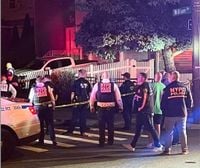On the evening of August 15, 2025, a stretch of William Avenue near Hylan Boulevard in Staten Island’s Great Kills neighborhood was transformed by a tragic confrontation that would soon ripple across New York City. Jesse Campbell, a 44-year-old Staten Island resident with a lengthy and troubled history, was fatally shot by an off-duty New York Police Department officer after he pointed a hyper-realistic BB gun at police outside Andrew’s Diner, just a block from his home. The incident, captured on surveillance video and confirmed by multiple law enforcement sources, has reignited conversations about mental health, policing, and the unpredictable dangers faced by officers and civilians alike.
The chain of events began around 8 p.m., according to Assistant Chief Melissa Eger of NYPD Patrol Borough Staten Island, who spoke at a news conference just after midnight. A 911 call had come in reporting a man with a gun at the rear of a local diner. Not long after, an off-duty officer spotted Campbell, who appeared to be holding a firearm, and quickly alerted another off-duty officer nearby. The officers confronted Campbell, repeatedly ordering him to drop the weapon. Instead, as Eger described, Campbell “pointed it at them,” escalating the situation to a deadly standoff.
“Our officers were confronted with a dangerous and unpredictable situation, and they attempted to de-escalate the situation multiple times,” Eger said, as reported by ABC News. Despite their efforts, the officers’ commands were met with resistance, and one officer ultimately fired multiple rounds, striking Campbell several times. The officers immediately performed life-saving measures before Campbell was transported to Staten Island University Hospital, where he was pronounced dead. The entire incident was recorded on surveillance footage, which police say clearly shows the sequence of commands, escalation, and the final moments of the encounter.
Authorities quickly identified Campbell as the man fatally shot. According to CBS News and other outlets, Campbell was well-known to law enforcement. His criminal record included at least 22 prior arrests, with charges spanning second-degree assault, criminal trespassing, petit larceny, and narcotics offenses. Notably, in 2023, Campbell had been arrested for throwing a “porch bin” at a pair of NYPD officers, resulting in assault charges. He pleaded guilty to those charges and, as part of a plea deal, was participating in Mental Health Treatment Court until earlier in August 2025, a spokesperson for the Staten Island District Attorney’s Office confirmed.
Yet, the events leading up to Campbell’s death were not entirely unforeseen by those closest to him. Multiple reports, including those from the New York Post and Hindustan Times, reveal that Campbell allegedly told his mother and sister earlier that day that he intended to be killed by police. This revelation has cast a somber light on the entire episode, suggesting a possible case of “suicide by cop”—a phenomenon in which individuals provoke law enforcement into using deadly force against them.
Community members and family painted a picture of a man struggling with deep-seated issues. One local resident, speaking to the New York Post on condition of anonymity, said, “He’s not all there mentally, he’s got some problems.” The resident described Campbell as “a good kid” who had faced significant challenges, including the trauma of his brother being paralyzed in a car accident 15 years ago. “His mother and father are great people, good family,” the neighbor added, underscoring the sense of loss and confusion gripping the community.
Another family member, quoted by the Hindustan Times, said the tragedy had left the family “all damaged up.” He described the situation as “heartbreaking,” uncertain whether Campbell had truly intended to provoke the fatal outcome or if it was a tragic miscalculation fueled by mental distress and alcohol. “I think he was just drunk or something, probably running around joking around with a BB gun, and I guess whatever happened, happened,” said the local resident, reflecting on the unpredictable nature of the evening’s events.
The BB gun Campbell wielded was described by police as “hyper-realistic,” with a piece of tape around its grip. Photos released by the NYPD show an imitation firearm nearly indistinguishable from a real weapon, raising the stakes for officers who must make split-second decisions in high-pressure situations. Assistant Chief Eger confirmed that an imitation firearm was recovered at the scene, and emphasized that the officers “performed life-saving measures” even after the shooting—demonstrating, she said, their commitment to preserving life whenever possible.
Campbell’s previous interactions with the criminal justice system further complicate the narrative. His participation in Mental Health Treatment Court was intended to address the underlying issues contributing to his run-ins with the law. According to a spokesperson for the Staten Island District Attorney’s Office, Campbell’s involvement in the program ended earlier this month, just days before the fatal incident. The timing has prompted renewed scrutiny of how mental health and criminal justice systems intersect—and sometimes fail—the city’s most vulnerable residents.
The shooting remains under active investigation, with NYPD officials promising a thorough review of the officers’ actions and the broader circumstances. As AP News noted, the details of Campbell’s criminal history were not immediately clear to all officials at the time of the shooting, but subsequent reporting has filled in much of the picture. Police have stated that their actions were dictated by the apparent threat posed by Campbell’s realistic-looking weapon and his refusal to comply with repeated commands.
The case has struck a nerve in Staten Island, where residents are grappling with the aftermath of a violent confrontation that unfolded in their own backyard. For some, the incident underscores the dangers faced by police officers who must react quickly to ambiguous threats. For others, it is a stark reminder of the challenges posed by untreated mental illness and the limitations of the systems designed to help those in crisis. The fact that Campbell’s family and neighbors describe him as troubled but fundamentally good only deepens the sense of tragedy.
As the investigation continues, the story of Jesse Campbell’s final hours serves as a sobering reflection on the complexities of policing, mental health, and community in modern New York. The intersection of personal struggle, public safety, and institutional response leaves no easy answers—only the hope that lessons will be learned to prevent such heartbreak from repeating itself.






